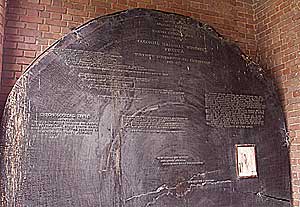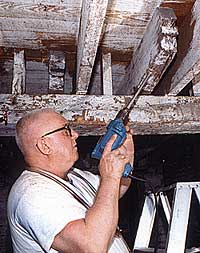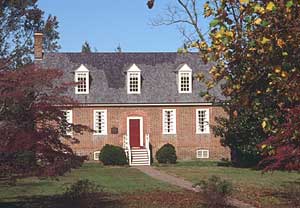Page content
Peering into Rings of Grain
Dendrochronology comes of age, shedding new light on the shape of old America
by Michael Olmert
The English poet laureate Philip Larkin wrote:
The trees are coming into leaf
Like something almost being said.

Photo by Dave Doody
Cut from the trunk of a California sequoia that fell in 1917, this cross section demonstrates the accumulation of rings with the passage of time, 1,995 years. It was presented to the Colonial National Monument for the Yorktown Sesquicentennial in 1931 and stands today at Hampton University.
And what those trees say seems to be: “Look here.” To historians they whisper about the past; they record their growth in annual rings whose thickness or thinness is a dependable and consistent record of the climate for the year. They could scarcely be more articulate.
Each ring’s width is a function of rainfall, temperature, and sunlight, though forest fire, disease, and insect infestation are also implicated in any ring’s size. Peer into a growth ring and you’re looking into a tree’s history for one season.
For instance, most trees alive in 1816 display a stunted growth ring for that year, clearly a result of the eruption of the Tambora volcano in Indonesia in 1815. For a year, its cloud enshrouded the earth and slowed the growth of everything dependent on photosynthesis. It was called “the year without a summer.” A similar 1601 volcanic eruption in Peru also affected tree-ring density over much of the globe.
For historians, the challenge is to associate a particular ring in, say, a stump or roof timber or log canoe with a particular year. To that end, foresters record tree-ring sequences of wide and narrow rings, starting with living trees, some of which are a record of life going back hundreds of years.
To extend a sequence back farther than the age of living trees, you look at timbers from old buildings or bridges, and match their youngest sequences with the oldest sequences of the living trees. Find enough old timber and you can trace a sequence of tree rings back indefinitely. One caveat is that all the timber in a sequence must be from the same species because different species respond differently to drought or flood.
To date an artifact of wood, the trick is to fit its tree-ring pattern into the overall tree-ring sequence for its region. Moreover, if you can find a timber that still has bark clinging to its outer ring, that last ring will be the year the tree was felled. It’s called the “wane edge” of the timber, a logging term possibly derived from a phrase like “the waning of summer,” or “the waning of the moon.”
As you might expect, the wane edge—often found on the bottom, undressed sides of floor joists that no one was ever expected to see—is important in dating buildings made of wood. “You may think your building dates from 1680,” historians are regularly told these days, “but its timber wasn’t cut until 1729.”
Ouch.
The Virginia trees most useful to historians are red and white oak, tulip poplar, and southern yellow pine. Sequences for them have been worked out well back into the colonial period. But possibly the most famous tree in dendrochronology is the bristle cone pine of the American Southwest, a species that often lives several thousand years. It’s nothing less than congealed, deep time-a record so accurate it has been used to calibrate the high-tech carbon-14 dating system.
It was the longevity of pines that suggested the use of tree rings as a very-long-term annual clock, an idea developed by Andrew Ellicott Douglass at the Lowell Observatory in Arizona in the first three decades of the twentieth century.
An astronomer, he was frustrated by the lack of dependable meteorological data for his study of sun-spot cycles. In ponderosa pines he saw the possibility of relief. His work brought tree-ring dating to the attention of historians and created the science called “dendrochronology,” a word coined in 1928. Dendron is Greek for “tree,” so the newly minted word was meant to be read as the study of “tree time.”
The basic tenet of this science, “one ring, one year,” is something Larkin understood, especially the bit about the annual renewal of trees:
Is it that they are born again
And we grow old?
No, they die too.
Their yearly trick of looking new
Is written down in rings of grain.
In Virginia, the long-lived species is the bald cypress. Some specimens growing along the Nottoway and Blackwater Rivers are capable of telling us about the state of the environment extending back eight hundred years.
Dennis Blanton, an archaeologist at the College of William and Mary, used bald cypress cores to study climate conditions during the experiment of settling Virginia. The rings suggest a reason for the hardship associated with the founding of the Jamestown colony. “The trees indicate,” Blanton says, “that the most severe seven-year regional drought in the last 770 years occurred between 1606 and 1612.”
Tree rings are seldom enough to tell a story in themselves, but combined with early Jamestown documents, they underscore a tale of woe. Those first years, 1607 and 1608, are thought to have consumed the lives of 144 out of 244 colonists. The chroniclers of those events commented on the shortfalls of the native corn harvests and the unwillingness of the Indians to trade or share their maize with the English. It was “meere famine” that got them, eyewitness George Percy wrote. Now we know why. Possibly.
Today, forest entomologist Herman J. Heikkenen is an icon in the world of dendrochronolgy. “Jack,” as he is called, is in his seventies and has a casual, rough-and-ready aspect. He is quick with self-deprecating jokes and with reminiscences about his stern Finnish upbringing in Michigan. He spent the summer of 1950 in Idaho as a parachutist firefighter. “I jumped out of the first eight airplanes I went up in,” he says. His white hair is cropped in a buzz cut, a lingering tribute to his enlistment in the Korean War. He seems as much football coach as forest scientist.
His Ph.D. from the University of Michigan had to do with the links between insect infestation and forest growth. A professor of forest entomology at Virginia Tech in Blacksburg, he got into tree-ring dating as an exercise for a local Boy Scout troop, designing a way for it to uncover the vintage of the troop’s old cabin. He never looked back and has spent the past twenty-five years helping architectural historians throughout Maryland, Virginia, and North Carolina, and as far north as Maine, determine the age of the buildings they studied.
Jack Heikkenen’s great addition to dendrochronology is the “key year” concept of tree growth. “The whole system comes down to this,” Heikkenen says. “Each year’s growth ring, compared to last year’s, can be only one of three things: greater, which is recorded as a plus; equal, which is a zero; or less, which is a minus. Because you get so few zeroes, the result is a plus or minus pattern for the annual rings in any given tree.

Photo by Williw Graham
Dendrochronologist Herman J. Heikkenen uses a power drill to take a sample core of flooring timber in the Dora Armistead House. He’s looking for traces of a colonial coffeehouse.
“Then, if you look at a sample of trees from a certain locale, you may notice that twelve out of fifteen will all show a plus or a minus for a particular year. That will be a ‘key year.’ The pattern of key years can be matched up with the pattern in the wood of a house whose date is in question.” A computer calculates the fit and probability of error for the date the wood was cut.
All together, Heikkenen’s system ranges from boring hollow-bit cores out of house timbers, to polishing the cores, to measuring each ring in the cores under a microscope, to pushing a button that declares whether a ring is a plus, minus, or a zero, and finally to dumping all this into a computer that compares the strings of pluses and minuses with data on local or regional trees. Heikkenen has patented the system, and it’s changing the way we look at our colonial past.
Ed Chappell, head of architectural research at Colonial Williamsburg, says: “Jack’s dendro has helped reinvigorate the study of early buildings in the Chesapeake region, and more specifically at Colonial Williamsburg. A generation of historians has recast the story of colonial architecture in Virginia and its neighbors from a relatively static plot to one of dramatic, continuing change. Dendro has placed the right characters on the stage.”
For instance, the Lynnhaven house in Virginia Beach was long thought to be a seventeenth-century structure-from the 1600s. But timber cores from its basement showed that the wood was cut in 1724. “At this point,” Heikkenen says, “various people in authority had what is professionally known as a conniption.” When follow-up archaeology was done close to the foundations of the house, lead cames that had fallen from the windows were seen to be stamped with dates close to 1724. “Please,” Heikkenen says, “it’s not my fault. It’s just the way science progresses.”
Similarly, Smith’s Fort in Surry County, just across the James River from Jamestown, usually dated through a court report that refers to a brick house on the site in 1674, was redated by Heikkenen to the 1760s, almost a century later. Stratford Hall was found to be 1738, not 1725.
Heikkenen, a forester and bug man from southwestern Virginia, who made no claims for any expertise in architectural history, had officially become a disturber of the peace.
And that’s just what we wanted,” says Mark R. Wenger, a Colonial Williamsburg architectural historian. “He was about to cause a revolution in the history of Chesapeake architecture.” And so, in the early 1980s, Heikkenen came to Colonial Williamsburg.
It wasn’t that his technique wasn’t trusted; it was just considered prudent to let him loose on a few structures whose dates were solidly based on documentary evidence. “But we didn’t share those dates with Jack,” says Willie Graham. Another foundation architectural historian, Graham has been working with Heikkenen for the past two decades. “We threw him some ringers.”

Photo by Dave Doody
Dendrochronology showed that this Surry County, Virginia, building was not, as tradition held, associated with Pocahontas’s son. The wood of the framing showed it is too recent.
For instance, Heikkenen found that the trees used in Bruton Parish church were felled between 1709 and 1714, which fit with the dates associated with the church; the vestry agreed to build the church in 1706 and it was completed by 1715. Heikkenen showed that the timbers for the 1770 tower were cut after the growing season of 1769.
It’s incredible how close the dendro focus can be. If you’ve got a wane edge, or “waney edge,” as Heikkenen sometimes says, you’re seeing the last year of tree growth. “But it’s no big deal to date a timber to a half year, because we can differentiate the spring wood from the summer wood growth.” The spring wood is laid down in thin-walled, large-diameter cells, followed by thick-walled, small-diameter summer cells.
The work also tells us about the nature of early logging. “Most timbers,” Heikkenen says, “show summer-wood growth but no spring-wood growth, strongly suggesting that logging was done in the wintertime. It makes sense, because the amount of snake, chigger, and tick activity is reduced. Also, your farm animals are kept in shape for spring plowing. And if you happen to have a bit of frozen ground, then the skidding is much, much easier.”
The other feature of the Heikkenen system is that it is consistent not only within a local growing area but regionally. When you look at the key dates for three widely separate areas-in Surry County, Virginia, on the western shore of Maryland, and in Montgomery County, southwestern Virginia-the patterns are remarkably similar for the decades of the 1920s, the 1820s, and the 1720s. It inspires confidence in the system.
Still, these regional results are mainly for a single species of tree. Locally, of course, the ring patterns are similar even between species. That is, within a given stand, most trees will exhibit the same pattern no matter their species. But when you look at the oak patterns across a wide area, you see they’re responding differently to the weather than the pines are. This can cause problems for dating buildings in ports, like Alexandria, Virginia, where logs might come from Philadelphia or even from New England. In Williamsburg, however, most of the timber was locally felled.
The trouble in Williamsburg was that there is slim documentary evidence for some buildings. We may know, for example, that a lot was bought in 1713 and that there was a legal requirement for every lot to be built on within two years or the land would revert to the city corporation. In the absence of conflicting information, a date of 1715 would be assigned.
Heikkenen’s work ended all that. Soon, his results began to tumble in. Heikkenen determined that the James Geddy House was built in 1762, though it was considered to have been erected between the 1710s and the 1750s. We can now say it was built by the silversmith James Geddy Jr. and not his father, the gunsmith, who was dead by 1760. The Booker Tenement on Nicholson Street, previously dated by nails and moldings to 1815-1830, was shown to be built of logs cut in 1823.
The evolution of the Randolph House is now clearer. William Robertson built the western part using timber cut in 1715, 1716, and 1717. Oak used for a gutter came from a tree felled in 1718. Peyton Randolph brought the house to its present state in 1755, using wood felled at the end of the 1754 growing season.
Some house dates were pushed farther back than anyone dared believe. The Nelson-Galt House on Francis Street, thought to have been standing by 1718, was shown to have within it the shell of an older house the wood of which was cut at the end of the growing season of 1694, predating the incorporation of Williamsburg. That is, an older house was probably moved to a new foundation on this lot within the grid of the new town. In essence, it’s a seventeenth-century house.

Photo by Willie Graham
Colonial Williamsburg's Willie Graham shows a core sample taken from a timber at Tuckahoe—a Goochland County home where Thomas Jefferson spent his infancy.
Heikkenen’s dates have contributed to solving more complex puzzles in the town. Architectural historians found more than a hundred eighteenth-century building fragments recycled in the 1890s Cary Peyton Armistead House standing on the site of Richard Charlton’s Coffee House near the Capitol. The coffeehouse was demolished just before the Armistead House’s construction, but are pieces of its framing and woodwork from the coffeehouse, or from some other eighteenth-century structure? Asked to date the framing, Heikkenen found it to have been cut in 1749, matching nicely with a 1750 description of the coffeehouse as “lately Built.” Much of what is known about Charlton’s comes from the fragments, now pieced together with the aid of computers.
“What Jack’s work has done,” Wenger says, “is that it’s put the study of our houses and our town on a firm scientific basis. I believe in the system, but it’s still got to be used in concert with all the other bits and pieces of the past that we know.”
Dendrochronology was never meant to be an end in itself, just part of a wider line of an inquiry into the origins of life in the town and how it grew. Precise dates are where history starts.
In the end, how nice it is to consider the many tools nature has bequeathed to us, hints and allegations about matters in which we might someday be interested. We have been designed, it seems, to scan our past. Those rings, nature suggests, can fill us in on how she works, and how we once worked with her. As Larkin wrote in 1967, trees have a great deal to tell us:
Yet still the unresting castles thresh
In fullgrown thickness every May.
Last year is dead, they seem to say,
Begin afresh, afresh, afresh.Michael Olmert wrote about the church at Bruton, Somerset, England, in the winter issue.
